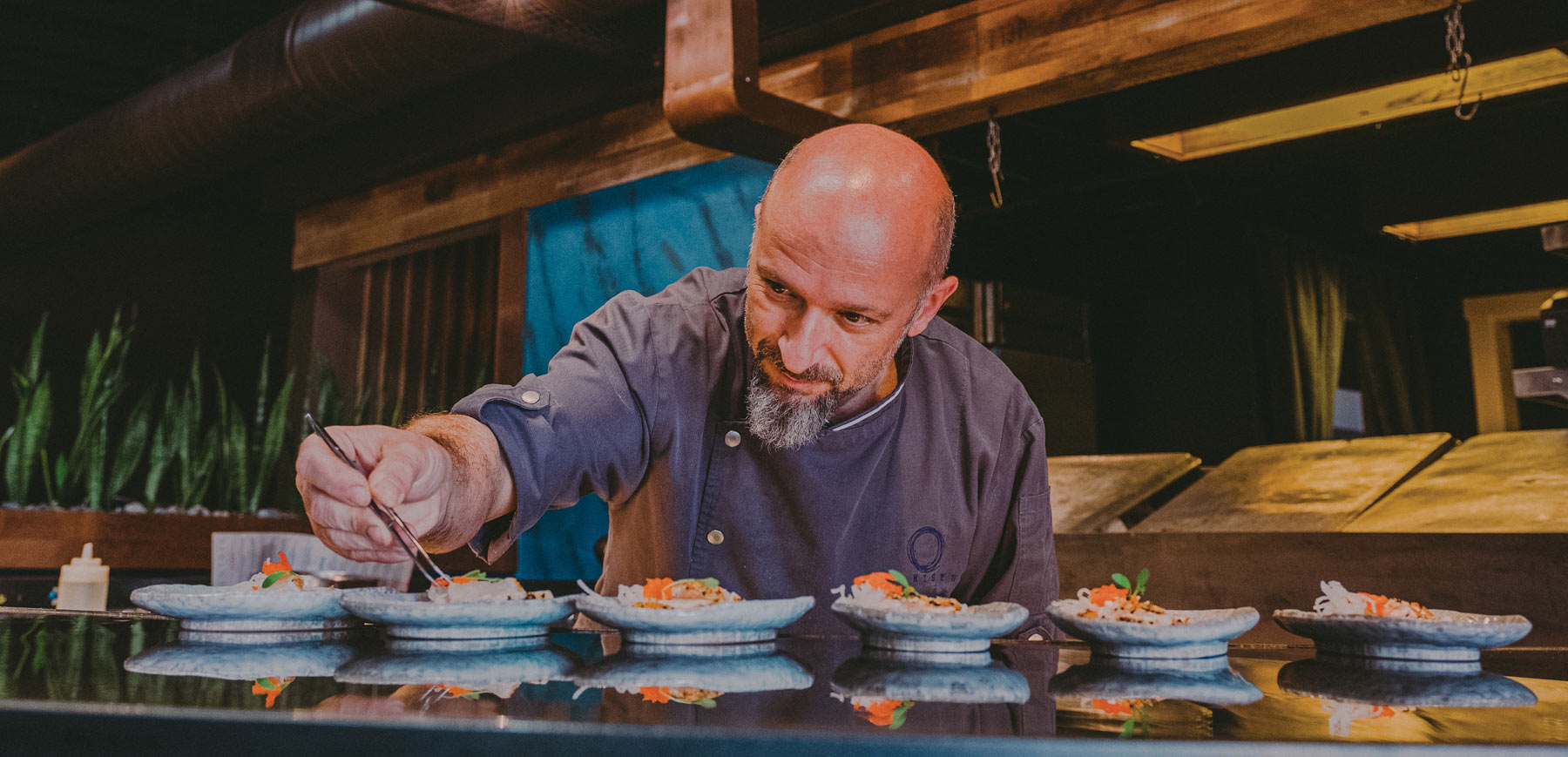
A Seat at the Chef’s Table
Behind swinging doors, clouds of steam and echoes of sizzling and clinking, there is a world inside every restaurant only privy to chefs and their staff.
Photos by Richard Fusillo
For years, only a handful of lucky individuals including close friends and loyal patrons would have the honor of getting a glimpse behind the curtain as a VIP perk and an invite-only, sensory experience where multiple courses would be served within or in close proximity to the kitchen they were being crafted in. Chefs would prepare and serve a specialty tasting menu, while guests had the unique opportunity of engaging with the head chef and experiencing their meal in a heightened way.
This esteemed and exclusive experience is known as the Chef’s Table.
Some would argue that the concept of the Chef’s Table has been a tradition long before special invitations or titles, dating back hundreds of years. Due to long working hours, chefs would feed their families and entertain friends in the kitchen while they worked. It was also common for the cooking team and waitstaff to dine together in the kitchen before the nightly circus began, giving the crew time to fuel up and taste the evening’s specials.
Over the last few years, this private routine has evolved into a dining experience highly sought out by the public and promoted by some of the world’s most notable restaurants. Here in San Luis Obispo County, Chef Nicola Allegretta has finally been able to execute the Chef’s Table at his new location of the popular Mistura restaurant, now open in San Luis Obispo after a move from Paso Robles.
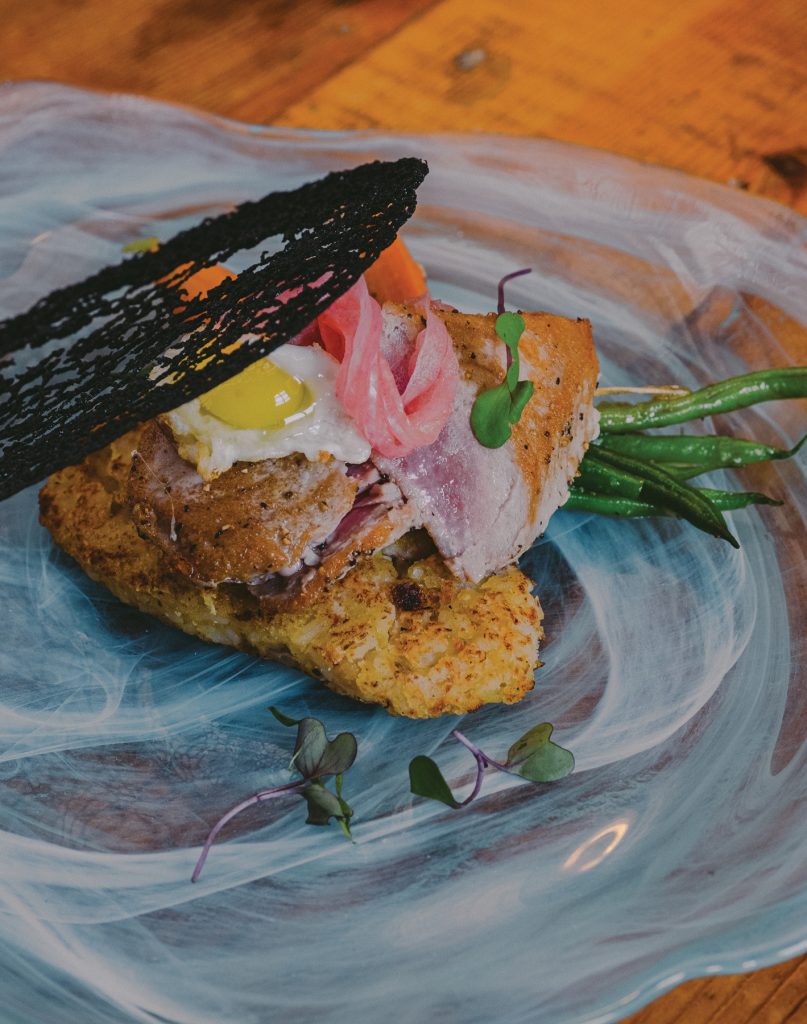
“Fifteen years ago, I had no restaurant. Instead, what I would do is I would arrive at a host’s house and cook for their group of two to 10 guests. I would be on one side of the counter in their kitchen, with their friends sitting on the other side. I would cook and interact with the guests, pairing food with wine. That level, to me, is what a true Chef’s Table is. The difference now is that in the restaurant, it is a little more formal, nicer and organized.
“I’ve been to many Chef’s Tables myself, and one of the greatest experiences was with my wife at a place in Lima, Peru called Astrid & Gastón, located in Casa Moreyra.” The restaurant was founded by Peru’s gastronomic godfather Gastón Acurio and pastry chef wife Astrid Gutsche. “We arrived at 1pm and were given a 22-course meal with a wine to pair with each course. Just think of 22 different wines! By the time we left, it was well past 5pm. It was such an amazing experience, you can’t even imagine,” continues Chef Nicola. “This, Joël Robuchon’s in Las Vegas at the MGM Grand, and many other restaurants [were an inspiration] and made me realize we needed something similar here on the Central Coast.”
At Mistura, guests are seated in a room next to the cellar, where they are treated to dishes using “local, organic, sustainable foods — really whatever foods are proposed to us by the fish market or purveyors — and then we use our creativity to put dishes on the table,” says Chef Nicola. “It is nice because we get the opportunity to express our passion by going out to the table and performing this art in front of our customers.”
Moving up to North County, Chef Ricky Odbert has taken Six Test Kitchen from Arroyo Grande to Paso Robles, a true dining experience that is an iteration of the Chef’s Table. Here Six Test Kitchen seats 12 guests (double the amount that could be hosted at the Arroyo Grande location).

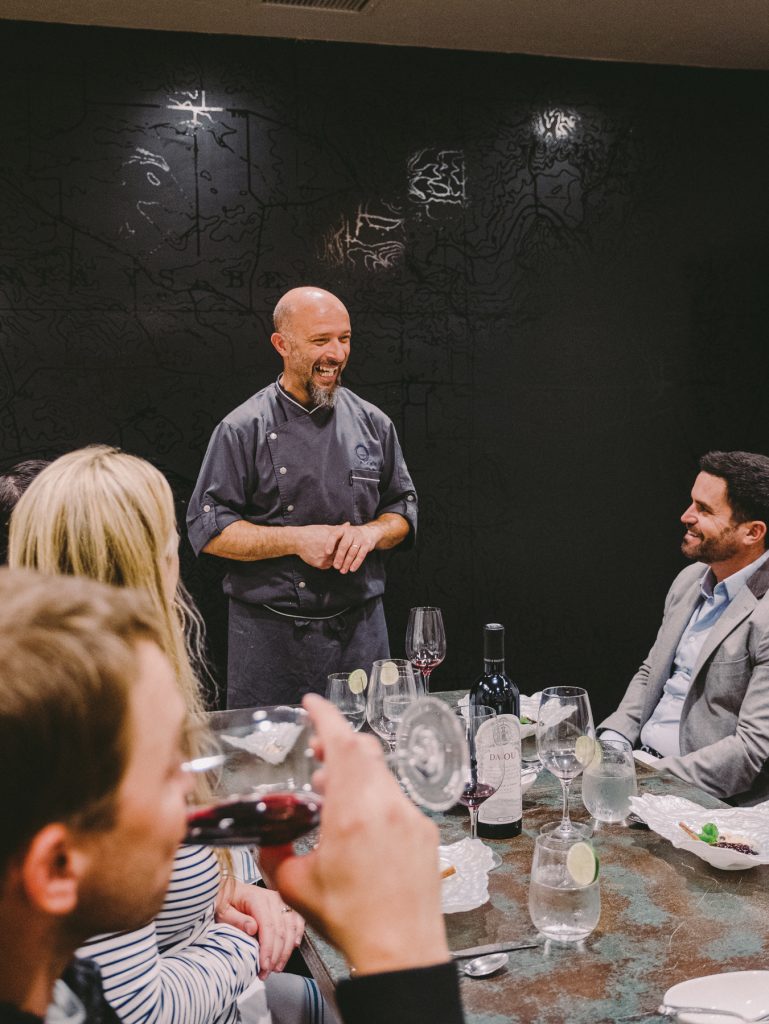


Chef Ricky comes from a deep culinary background, starting as a dishwasher at 13 years old, being paid under the table since he wasn’t legally allowed to work. Once old enough to get a work permit, he landed a job as a prep cook before moving to San Francisco to study at the California Culinary Academy the week after turning 18. His résumé afterward reads like a culinary guide of where to eat in the Bay Area, having worked at Masa, The Restaurant at Meadowood, back to Masa, Spruce, Aziza and then returning to Arroyo Grande to open Six Test Kitchen.
He and Sous Chef Matt Corella make their own vinegars, fermented ingredients and garums, allowing them to pull from a larger repertoire of ingredients with varying degrees of depths; they sometimes spend months working on dishes. The menu changes based on what is available and what is local. “Anyone can cook a carrot or a piece of chicken — that is what separates us. One of the biggest challenges is deciding how an ingredient will be represented in a dish, and we are not interested in the mundane,” states Chef Ricky.
The menu begins with a series of small, one-bite courses, and ends with a series of small, one-bite courses. The dishes in between are a reflection of Chef’s knowledge, time, experience and skill, with much opportunity to spend time talking to one another, having questions answered and enjoying the time together. “When we have the chance to spend time talking to our guests, the connection is very real. It is very relaxed. Comfortable. We want guests to feel like they are in our home.”
And for Chef Ricky, food service in this format is financially smart as well. In the restaurant industry, labor cost and rent “are the biggest expenses which can be detrimental to a new business. The control we have over our guests’ experience begins very early on, starting with the plate ware. As of now, about 80 percent of the plates used in the restaurant are designed by myself or by our potter, which allows us to curate a very specific experience. Our style of service allows us to directly connect with each guest throughout the 14-course menu without the need to rush guests to fill the next seats. When guests book a reservation, they have those seats for the entire night.” Each element of the service is well planned out.


Contributing to the rise in the popularity of the Chef’s Table was the 2015 premiere of Netflix’s “Chef’s Table,” a culinary docu-series profiling chefs from around the world and highlighting the culinary movements that changed the game. The program not only gave viewers a glimpse into the kitchens of renowned chefs like Massimo Bottura, Cristina Martinez, Corrado Assenza and Jeong Kwan, but also became cutting edge in the way food was captured and presented on film, from ideation and preparation to the final masterpiece.

Today, the Chef’s Table experience depends heavily on the restaurant and the chef’s preference. Some prefer a traditional table in the kitchen seating anywhere from six to eight people, while others have created private rooms adjacent to the kitchen. These rooms oftentimes have glass windows so guests can enjoy the intimate experience of watching their food being both prepared and plated, without the added elements of noise and heat.
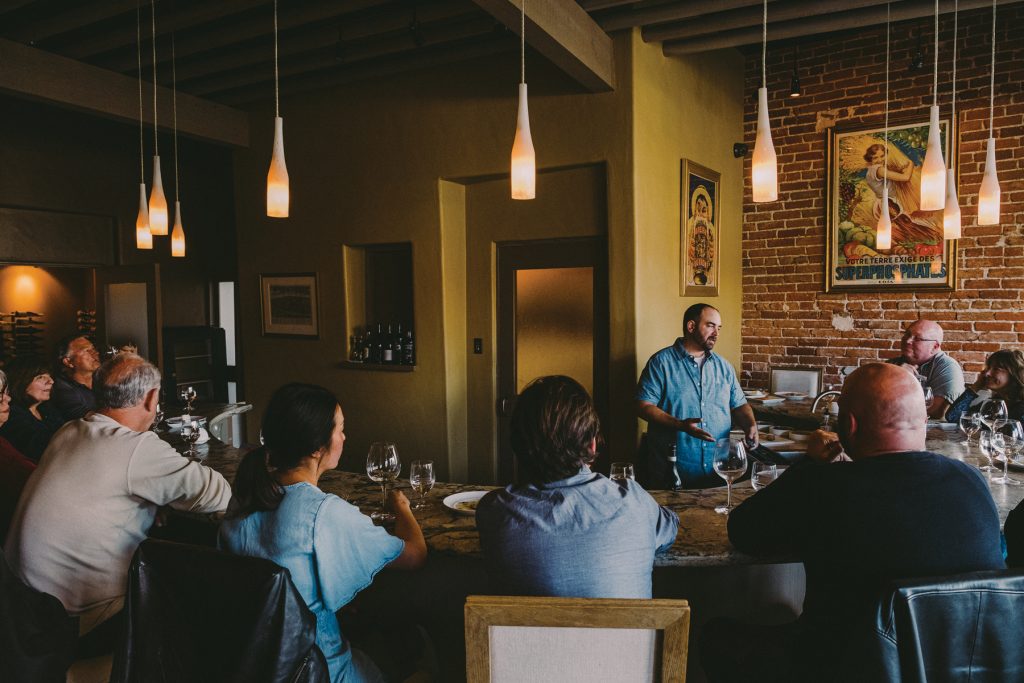
In Paso Robles, Sommelier Ian Adamo created his own version of this intimate experience at Somm’s Kitchen. Fourteen guests sit at a long curved bar, so they can see and interact with one another. To Ian, food, wine and serving others is his passion. “To be able to see people’s reactions, answer their questions and make them feel comfortable is so important to me,” he says. He tells the story of the ingredients, and how they are sourced and then prepared, placing an equal emphasis on the wines, having each guest sample 12 to 14 wines throughout the seating. “I really hope everyone walks away understanding the wine’s place of origin, varietals used and quality level. Most importantly, I hope they understand what they like and don’t like about a wine.”
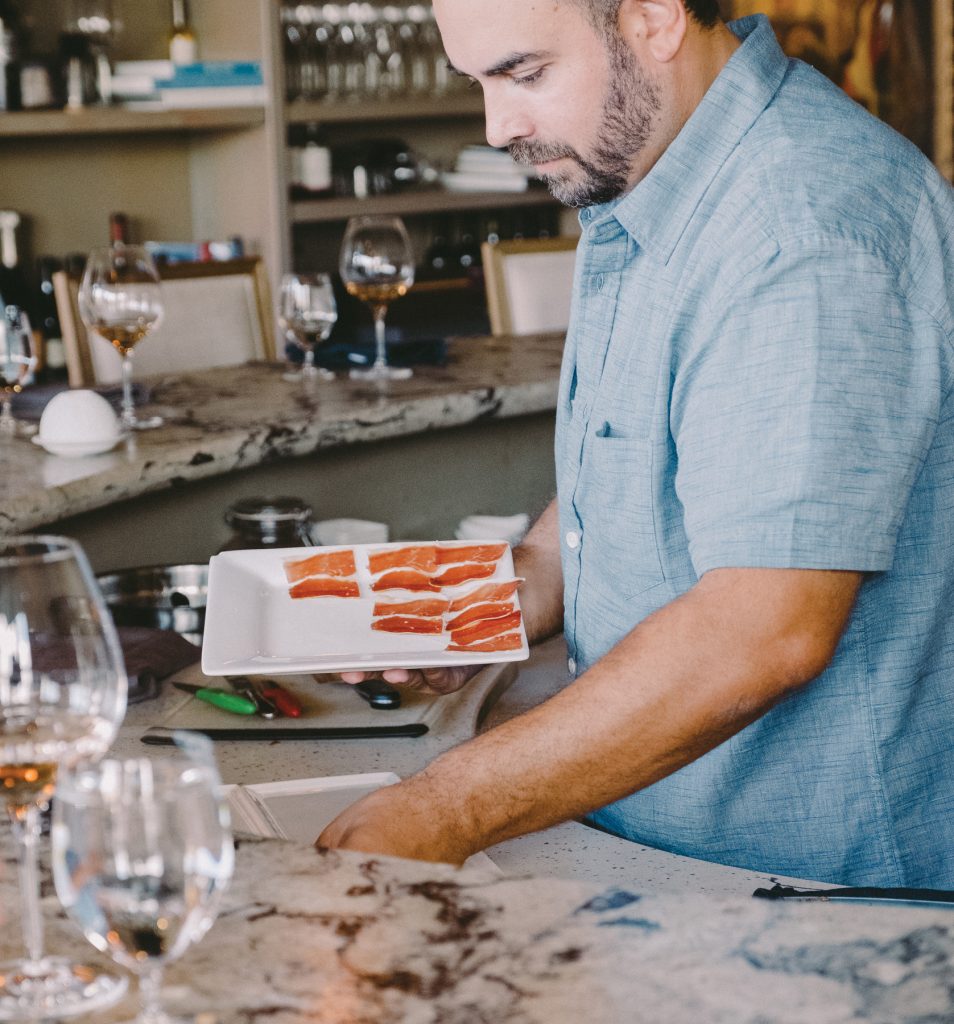
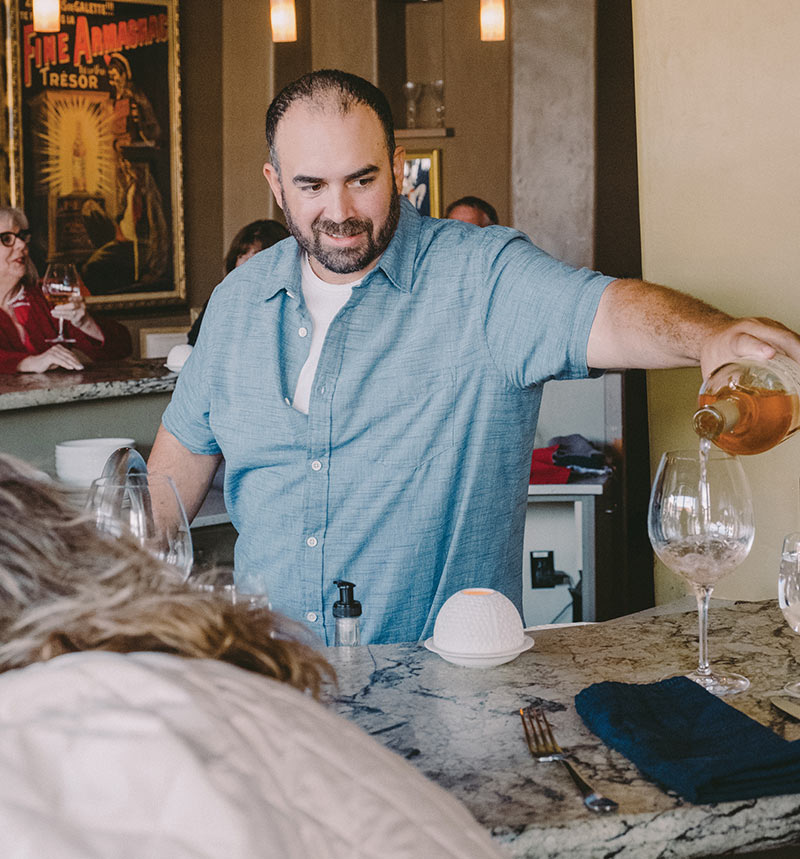
When guests arrive, Ian welcomes each with an apéritif, usually a dry white or rosé. After all are seated, the first treat is served, which leads into a bubbles flight, usually a California sparkling followed by a true Champagne, with two courses. That is then followed by 10 courses with 10 different wines from around the world, starting with more European austere wines, gradually moving back to the area and ending with fruit-forward Paso Robles wines. The dinner finishes with seven small desserts.
For Ian, this love of food and wine started young and led him here. As a teenager he saved his money throughout the year to bring his family out to what he thought was the best restaurant in New York City at the time, always loving family and good food. “I wanted to create a dinner party every night. I really wanted the restaurant to be about the food, wine and good conversation.
“I worked both the front and back of the house since I was 13. I grew up in NYC and worked at Le Cirque, La Caravelle. I learned the most while working at Lampreia in Seattle — the restaurant won a James Beard Award while I was there. I’ve been lucky enough to do guest sommelier positions all over the world — China, Japan, U.K., Italy, France and Austria. But most of the places I’ve worked at had tables 15 feet apart, thick wine lists and servers hovering over you. I found it hard for guests to fully relax. This was my chance to break the mold of sorts.”
It’s no surprise the Chef’s Table has attracted the masses, especially in major cities with bustling food scenes and endless eatery options. It gives restaurants the opportunity to get creative and stand apart, and can also offer an insider’s look for visiting guests into the local food scene and neighborhood culture. With such a high demand, restaurants offering Chef’s Tables often require reservations or only offer the experience on a seasonal basis, and here is no exception. For a place like Somm’s Kitchen, reservations are generally booked a month in advance. Though, no matter which Chef’s Table you’re able to delight in, it’s guaranteed to be an evening of meaningful interactions, culinary education and a customized multi-course meal not to be forgotten.

